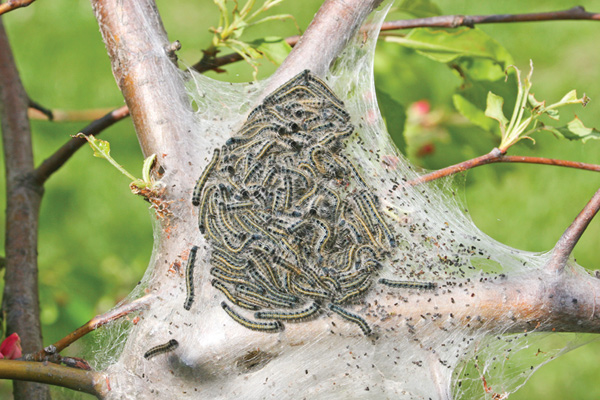Destroy them before they destroy your trees Tent caterpillars


Tent caterpillars are pictured above.
By Stephanie Hughes
OSU Ext. master gardener volunteer
Eastern tent caterpillars (Malacosoma americanum Fabricius) are commonly found in trees during spring. The caterpillars can be mistaken for gypsy moths. They nest in the fork of branches, but do not enclose leaves within the web, as the fall webworm (Hyphantria cunea Drury) does. These caterpillars are active until June, whereas fall webworms are active July through September.
Both the eastern and the forest tent caterpillars are found in Ohio, but the forest tent caterpillar is most common in the eastern half of the state. Eastern tent caterpillars prefer wild cherry along the roadways, but they can be found in apples, crabapples, plums, peaches and cherry. Occasionally they are found in ash, birch, willow, maple, oak and poplar. The favorite food of the forest tent caterpillar is wild cherry, as well as oaks, maples, hawthorns and other shade and forest trees.
One or two colonies can exfoliate a small tree, and there are periodic outbreaks of numerous colonies. Defoliation early in the season is costly to a tree, expending vital energy to set new leaves. These worms can migrate en masse in search of food or new settings. Thousands can travel over streets, roads, driveways and sidewalks.
The eastern tent caterpillar makes a white silk web nest in the crotch of a small tree. Both the eastern and the forest tent caterpillars have thick tan hair, black in color, with blue and white mottling. The eastern has a diagnostic white stripe down the back; the forest has a series of keyhole-shaped spots.
They overwinter as eggs, attached to a small twig, as a shiny gray foam surrounding the twig, about 1 inch and this contains 150 to 350 eggs. These hatch early in the spring, as the tree buds show green. Tiny black caterpillars spin silk, form the tent, then migrate to new leaves, feeding from morning to early afternoon, then return to the web nest. Larvae lay silk trails as roadways for other larvae. They feed four to six weeks until the larvae are mature — about 2 inches long.
The mature leave the nest and the tree to build a cocoon. They spin a white or yellowish spindle-shaped cocoon and metamorphose into adults in two to four weeks. Adults are 1 inch, reddish brown, with two creamy white stripes across the front wings. Forest tent caterpillars do not make a nest, and adults have dark brown stripes. Upon emergence they mate, and the female attaches egg masses to a twig. Thus the cycle is complete. Next spring will see the next generation, one per year.
To rid your trees of these pests, clip the egg masses and destroy, removing them in early spring. If removing the web nests, use a glove, as the hairs of the caterpillar can cause irritation. Scrape the nest off of the tree and crush the caterpillars, or place in hot soapy water. Early morning or late afternoon will ensure the caterpillars are in the nest. Tearing open the web can allow predators entry.
These caterpillars can be controlled with biological agents and/or insecticide sprays (see OSU Extension bulletins for uses). Parasitic flies are natural enemies. Ground beetles and predacious wasps will eat them. Many birds, especially Northern orioles, will eat entire infestations.
For more information, see our fact sheet on tent caterpillars at http://go.osu.edu/tentcaterpillars
 43
43
